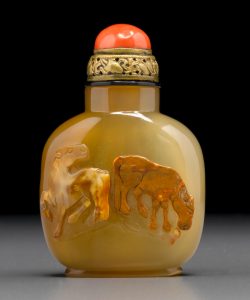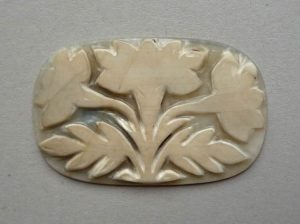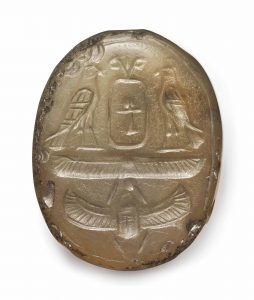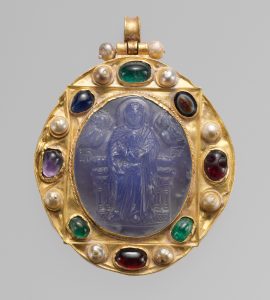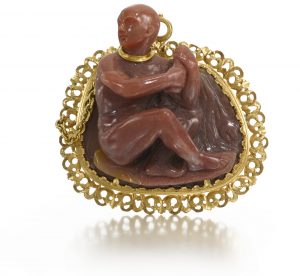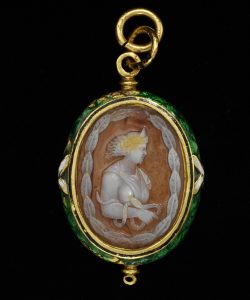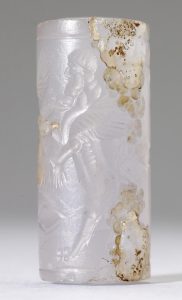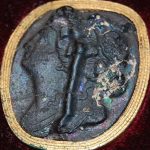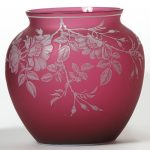Information on chalcedony and its use in cameos and cameo carving. Chalcedony is a type of quartz that occurs in several different forms including onyx and agate. It has a waxy luster, and may be semitransparent or translucent. It can assume a wide range of colors, but those most commonly seen are white to gray, grayish-blue or a shade of brown ranging from pale to nearly black. The color of chalcedony sold commercially is often enhanced by dyeing or heating. Reference: Wikipedia
A cameo chalcedony snuff bottle carved with two horses 1780-1850 2 3/8in (6cm) high
Sold for US$ 3,125 (£ 2,365) inc. premium at Bonhams in 2017
Cameo; chalcedony; rectangular; oval corners; plant with three flowers and two leaves; crudely engraved.
Reference: © The Trustees of the British Museum
A WEST SEMITIC CHALCEDONY SCARABOID CIRCA 9TH-8TH CENTURY B.C. The underside engraved in two registers divided by a winged solar disk, the upper register with two birds of prey flanking a cartouche containing the sign of Tanit, and the lower register with a winged scarab, enclosed within a line border, perforated 1 in. (2.6 cm.) long
Sold for USD 10,000 at Christies in 2015
Pendant Brooch with Cameo of Enthroned Virgin and Child and Christ Pantokrator
Date:late 1000s–1100s (cameo); 1100s–1300s (mount) Culture:Byzantine Medium:Chalcedony cameo; gold mount with pearls, emeralds, garnets, sapphires, and a sardonyx intaglio
The elaborately carved cameo depicts the enthroned Virgin and Christ Child flanked by archangels, a subject often depicted in the apse of Orthodox churches. On the reverse of the gold case is an image of Christ Pantokrator, which would have been found in the dome of a church. The frame is typical of the Rus’, peoples of the north who had been converted by the Orthodox Christian clergy of Constantinople and who thus prized Byzantine works.
Reference: The Metropolitan Museum of Art
Attributed to Giovanni Ambrogio Miseroni (circa 1551/1552-1616) Bohemian or Italian, Prague or Milan, circa 1600 HIGH RELIEF CAMEO WITH A CAPTIVE with paper note inscribed The Slave in rose agate out of the Wertheimer collection, possibly a reference to Emile Wertheimer Collection of Renaissance Jewels sold Sotheby’s London 13 July 1953 chalcedony, in early 17th-century gold mount 40 by 46mm., 1 9/16 by 1 13/16in. overall
his remarkable jewel is superlative for the quality of its execution. Beautifully carved, it represents a chained captive, his bald head indicating that he is of Oriental origin, probably Ottoman or North African. The very particular rose coloured chalcedony with yellowish hue, seen at the left edge of the parapet, compares very closely with works by the celebrated hardstone carver Giovanni Ambrogio Miseroni, who worked alongside his brother, the Imperial stone-cutter Ottavio Miseroni.
Sold for 11,250 GBP at Sothebys in 2018
Pendant with a chalcedony cameo of Cleopatra, based on a classical type of a Bacchante with snakes, in a contemporary enamelled gold frame with ribbon ties ca. 1840-1900 (made)
Reference: © Victoria and Albert Museum
Cylinder Seal with Genius and Human-Headed Lions
A four-winged genius grasps two winged, human-headed lions by their beards. The winged genius served as a protective guardian.
